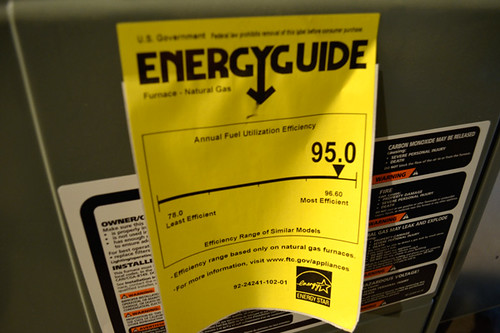
Pain-Free Guide to Choosing an HVAC System
Courtesy of HouseLogic
Do your eyes glaze over just thinking about an HVAC upgrade? This guide helps you cut to the chase when you’re ready to install a new unit.
Furnaces and air conditioners are mysterious. And like any mildly complicated thing, in the hands of the right person, they can be made to seem downright impenetrable. Here I was standing in the basement of my new house, thinking about the thousands of things that have to get done in the eight weeks left before I’m to move in, and the HVAC guy’s giving me a history of every furnace manufacturer going back to 1954, complete with personal anecdotes. Single-stage, multi-stage, variable speed, true modulating, power-vented, static pressure … when is this man going to stop talking? So you don’t have to feel dumb next time you have to deal with your HVAC (heating, ventilation and air conditioning) system, here’s the short version.
The Average Joe’s Guide to Furnaces
Gas-fueled forced-air heating is the most common type in the United States, and it’s what we have in our house.
1. It pulls cold air from the house and passes it around a heated metal box called a heat exchanger.
2. The heat exchanger transfers heat from the metal to the air.
3. A blower fan pushes the heated air through ducts that distribute it throughout the house.
The furnace that came with the house is almost 30 years old, and its heat exchanger is cracked; plus, it’s only about 60% efficient. So there was really no question about replacing it. Check out this great article on HouseLogic if you’re trying to decide whether to replace or repair your furnace.
Here’s our old furnace:
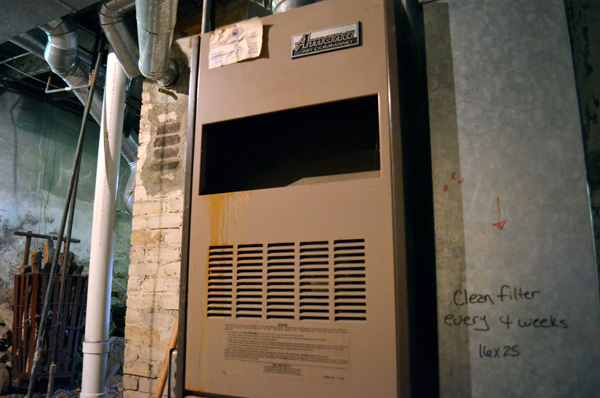
So, what kind of furnace do I get?
Despite the ramblings of my HVAC contractor, the options weren’t that complicated.
First off, we wanted a high-efficiency unit. You can still get 80% efficiency furnaces, and some people prefer their simplified design (fewer things to go wrong, the thinking goes). But 90% and higher efficiency furnaces have been around for decades now, so most of the reliability issues are gone. Plus, our energy company offers a rebate for installing them. We settled on a 96% efficient model.
The Goldilocks Comparison of 3 Furnace Types
Furnaces can be single-stage, two-stage, or modulating. They cycle on and off depending on where you set the thermostat. So the temperature in the house is always vacillating between high and low points, like this:
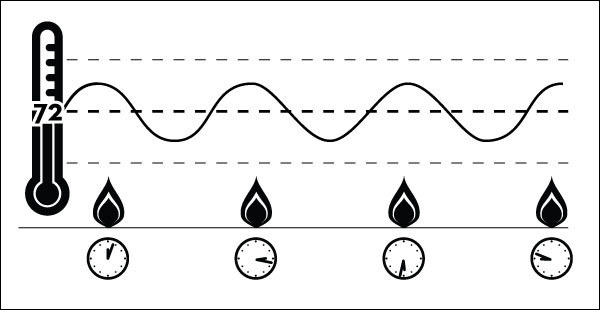
1. Single-stage is like a stove where the knobs only have one setting: high. Since a single-stage furnace can only be on or off, the result is greater peaks and valleys in temperature, and more inefficiency.
2. Two-stage has two settings, high and low. They’re better than single stage because they have a low-burning setting that keeps the heat from dropping too far below your desired point. And they’re more efficient because they keep the air temperature from varying as much as a single stage.
3. A modulating furnace is more like your real stove; it can adjust the flame to any point between off and high. It constantly adjusts its flame to try to keep the air temperature constant. In theory, this results in greater comfort and better efficiency. In practice, however, modulating furnaces are pretty new and unproven. Every contractor I talked to seemed hesitant about them, simply because the technology and parts are still new.
As Goldilocks might say, the two-stage furnace was just right for us.
Finally, we decided on a variable-speed blower, which means the furnace adjusts the fan speed in increments to precisely control the air flow throughout the house (unlike single-speed blowers, which can only go on or off). Like the modulating furnaces, these are supposed to provide better comfort and efficiency. Plus, because they convert AC power to DC, they use less electricity (DC power is more efficient).
Here she is:
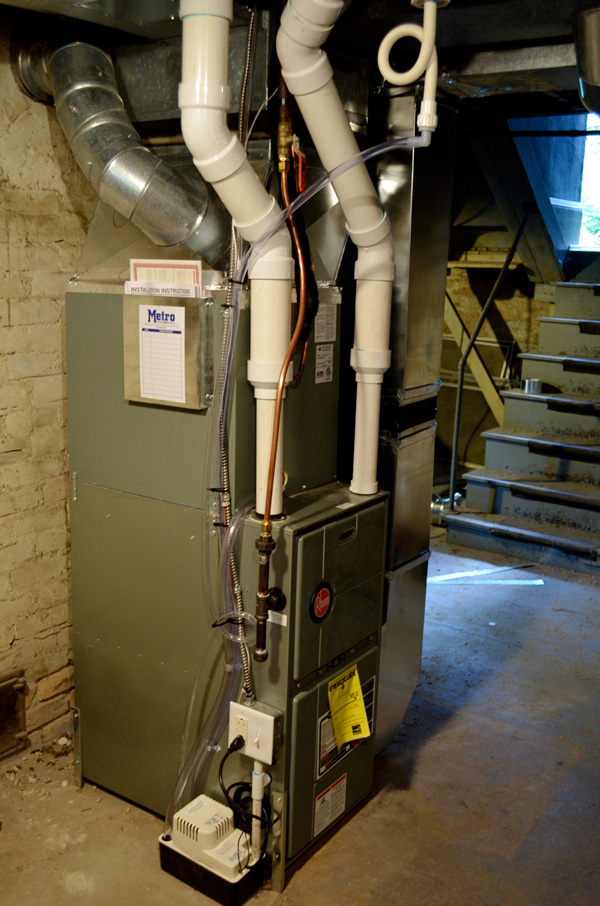
Don’t Duck the Ductwork
You might recall from last week that we had to have our old asbestos-laden ductwork removed — a slight setback to our timeline and budget, but well worth the peace of mind. Fortunately, our HVAC contractor quoted us a reasonable price for putting in all new ductwork, so we rolled that into the HVAC project.
Ductwork’s pretty simple (except for some nitpicky clearance and fireblocking — materials that impede fire in concealed areas), so there’s not too much to say about it … except, look how bright and shiny it is!

All About Air Conditioners
An air conditioner works just like a refrigerator.
1. A refrigerant (a substance that can go from liquid to gas at low temperatures) runs through a closed system of metal coils.
2. As warm interior air passes over these coils, the liquid refrigerant absorbs the heat (and turns into a gas) cooling the air, which is then blown back into the house through ducts.
3. The heated, gaseous refrigerant goes outdoors to the compressor (the big, loud boxy thing in your back yard), where it’s pressurized into a liquid form. As it turns back to a liquid, it releases heat, which is blown off into the exterior air.
4. The newly re-cooled refrigerant is sent back into the house to start the cycle all over again.
All air conditioners work on the same principle; when you replace yours, think about capacity, efficiency, and reliability. There’s a great HouseLogic article to help you get started evaluating an AC replacement.
AC efficiency: What You Need to Know
Air conditioner technology is getting better all the time. What used to be considered standard efficiency just six years ago is now below the minimum allowed by law. Air conditioner efficiency is denoted as a SEER (Seasonal Energy Efficiency Ratio) number. 13 SEER is the current minimum allowed.
Our energy utility provides rebates on anything above 14.5 SEER; we went with a 15 SEER for a balance of cost and efficiency. The higher the SEER, the more expensive the unit. But because of diminishing returns, going above 16 doesn’t necessarily equate to more energy savings.
The AC system’s capacity is measured, oddly enough, in tons. A ton of refrigeration is equal to the cooling power of one ton (2,000 pounds) of ice melting over the course of 24 hours.
Your HVAC contractor can help you decide on the capacity you’ll need based on the measurements of your home and its insulation values. We’re hoping to build an addition in the near future, and we wanted to make sure we’d have enough cooling power to cover the new square footage, so we chose a slightly oversized three-ton capacity unit.
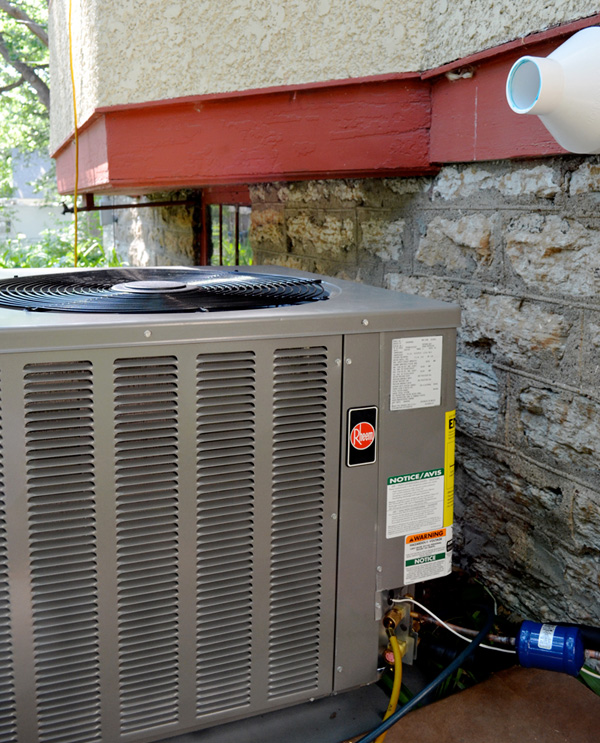
That’s it for a layman’s HVAC explanation. Hopefully, it’ll help you feel a little more comfortable when you think about replacing or repairing your home’s heating and cooling system.
...............................................................................................
visit my entire blog at http://blogs.har.com/cynthiamullins
Client Experience Rating: http://goo.gl/bCoMo
email cynthia@cynthiamullins.com
follow me at www.twitter.com/cynthiamullins
friend me at www.facebook.com/cynthiamullins1
see what people like about the Heights and what they think is its best kept secret at www.youtube.com/cynthiamullins
houston condominiums, houston highrises, houston home builders, houston home prices, houston home rentals, houston home value, houston homes, houston homes for rent, houston homes for sale, houston house, houston house value, houston houses, houston housing, houston listings, houston MLS, houston neighborhoods, houston new homes, houston properties, houston property, houston real estate, houston real estate agents, houston real estate associates, houston real estate brokers, houston real estate companies, houston real estate firms, houston real estate information, houston real estate listings, houston real estate market, houston real estate schools, houston real estate service providers, houston real estate solds, houston real estate values, houston realestate, houston realtors, houston relocation, houston schools, houston single family homes, houston sold home prices, houston sold homes, houston subdivisions, houston town homes, houston heights real estate housing market homes for sale buying selling inner loop properties houston texas tx OPEN Houses 1545 Heights Boulevard, Houston, TX 77008 77007 77009 houston heights realtor Woodland Heights Norhill Sunset Heights HISD Hogg Middle School IB Program Harvard Elementary Hamilton Middle School Reagan High School